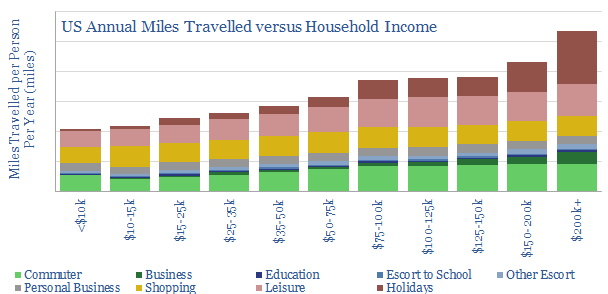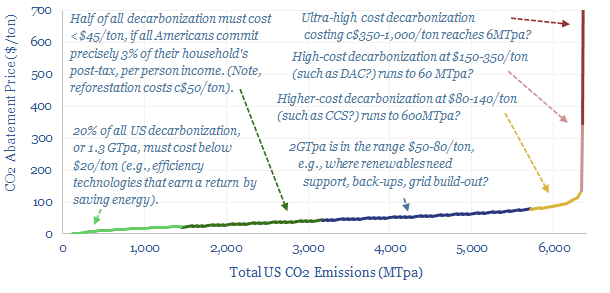How would CO2 abatement costs end up being distributed, if they matched the distribution of US incomes? Or to phrase it another way, what if all Americans hypothetically gave up precisely 3% of their household’s post-tax incomes, in order to decarbonize the country? 90% of all decarbonization would have to cost less than $80/ton. There would be a 600MTpa market for higher cost CO2 abatement at $80-135/ton (CCS?), a 60MTpa market for high cost CO2 abatement at $150-350/ton (DAC?), and a 6MTpa market for ultra-high cost abatement at $350-1,000+/ton (green hydrogen, e-fuels?).
CO2 abatement costs as a semi-liquid commodity?
Liquid commodity markets tend to have a single market price (e.g., $/bbl for oil, $/mcf for gas, $/Oz for gold), which is theoretically available to all producers, and tends to fluctuate around long-run marginal cost. Low cost producers earn excess returns selling at the market price. High cost producers may need to shut down when market prices cannot cover their variable cash costs. Very high cost producers usually do not get to develop their projects at all.
Is CO2 abatement a liquid commodity? Many readers will be familiar with our roadmap to net zero (note below), which is based on a cost curve of technologies that can decarbonize the world 3x over. We think it will be easiest to decarbonize the world by choosing as many options as possible from the lower-end of the cost curve, which yields an average CO2 abatement cost of $40/ton globally, an upper bound around $100/ton, and all of our various supply-demand models cohere with this decarbonization scenario for reaching net zero by 2050.
CO2 abatement is only a semi-liquid commodity in this roadmap. The global energy system is too complex for a ‘winner takes all’ approach to apply. Important considerations extend beyond simply cost. And there will always be a few downright lunatics who actually consider building small-scale wind turbines or drilling the bore-holes for a ground-source heat pump at their future home in Estonia, even though the CO2 abatement costs make their analytical eyes water.
Methodology: calculating the distribution of affordable CO2 abatement costs?
The purpose of this data-file is to quantify how CO2 abatement costs might end up being distributed, if they follow the income distribution in a typical, large, wealthy country such as the United States. Specifically, our data-file asks: “how would the US’s tolerable CO2 abatement costs be distributed, if every American committed precisely 3% of their household’s post-tax, per person income, to offset the nation’s CO2 emissions?”
To estimate this, we have downloaded data on US household incomes, percentile by percentile, converted into post-tax per person income, using data from the IRS, estimated the CO2 emissions in each income bracket (based on data and charts below). Then we simply calculate 3% of that post-tax per person income and divide by our estimate of CO2 emissions per capita in each income percentile (reference charts below).


Conclusions: market sizing for energy transition technologies?
20% of all US decarbonization, or 1.4 GTpa, must cost below $20/ton, if the distribution of CO2 abatement costs is to match the distribution of household incomes. This is because 20% of American households have a post-tax income per person below $10,000 per year. Generally, the lowest cost technologies in our roadmap to net zero are energy efficiency technologies, where the up-front costs of deploying these technologies are paid back by future energy savings. Many of these technologies are highly economic in their own right. As a rough conclusion, we expect over 20% of all the decarbonization will come from efficiency technologies, which matches our roadmap to net zero.

Half of all US decarbonization must cost <$45/ton, because the median American household earns $24,000 in post-tax, per person income, while the individuals in this household tend to emit 16 tons of look-through CO2 per person per year. There are still some forecasters in fantasy land (note below), thinking that the world can be decarbonized without paying for pragmatic decarbonization solutions, or rather by deploying technologies that cost several hundred dollars per ton, and would absorb over 30% of the average income of the median American. The best examples in the 4GTpa middle ground of pragmatic decarbonization technologies costing $20-80/ton of CO2 abatement include wind, solar, expanding power grids, scaling up natural gas and nature based CO2 removals.
Higher cost decarbonization technologies, costing in the range of $80-140/ton could scale up into the range of 600MTpa in the United States, if the distribution of CO2 abatement costs ends up matching the distribution of incomes, and we run up to the 99th percentile. This is an interesting number, because we think CCS and blue hydrogen are most often going to be in the range of $80-140/ton. And we have also estimated, in bottom-up analysis, that this is the kind of market size that US CCS could achieve (note below).
High cost decarbonization opportunities that cost around $150-350/ton could find a limited market of around 60MTpa (1% of total US decarbonization) if the distribution of CO2 abatement costs matches the distribution of post-tax incomes in the country. An example of a CO2 abatement technology in this approximate cost and size category might be DAC. Some buyers may be willing to pay a premium for DAC CO2 removal credits over reforestation removal credits due to higher perceived quality, especially around the dimension of CO2 permanence.
Ultra-high cost decarbonization opportunities that cost $350-1,000+/ton could find an even more limited market of around 6MTpa (0.1% of all decarbonization), if the distribution of CO2 abatement costs paid to decarbonize the United States matches the distribution of incomes. We think that green hydrogen will most likely fall in this abatement cost range, in the ‘upper 0.1%’ of CO2 abatement by cost; a kind of energy technology equivalent of the ‘upper 0.1%’ of households with a pre-tax income above $2.6M per year ($770k per household member). And indeed, there will probably be some niche deployments of green hydrogen. Some niches can also be economically interesting. And some rough maths is that 6MTpa of CO2 abatement from green hydrogen might require 1MTpa of hydrogen, absorbing 50 TWH of renewable electricity and supporting 18GW of electrolysers by 2050, while displacing 100 bcf of natural gas (0.3 bcfd, versus today’s 100bcfd US gas market). Whether these are big numbers or small numbers depends entirely on your mindset.
